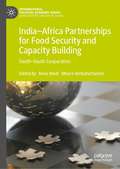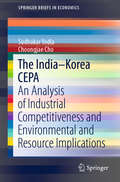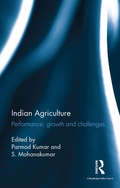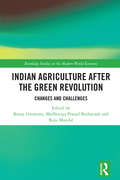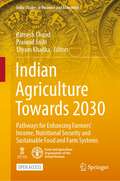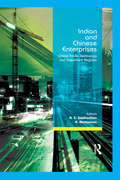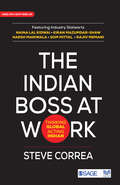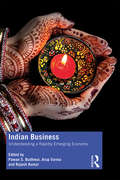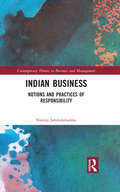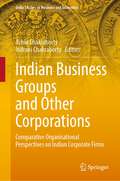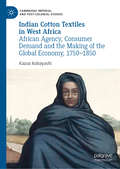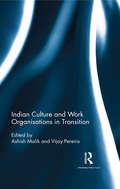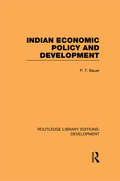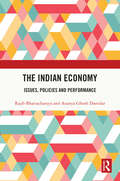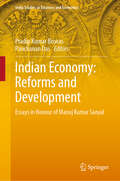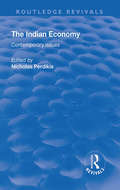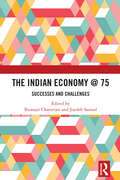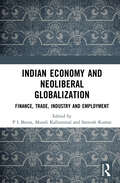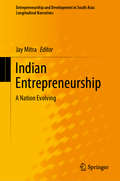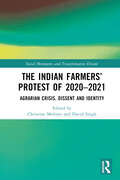- Table View
- List View
India–Africa Partnerships for Food Security and Capacity Building: South–South Cooperation (International Political Economy Series)
by Renu Modi Meera VenkatachalamThis compendium showcases the ongoing trends and challenges in South-South cooperation between India and select countries in Africa, for achieving food security and poverty reduction. Scholars and practitioners share diverse perspectives on the role of India’s development compact; aid, trade, private sector driven Foreign Direct Investments (FDIs), and concessional Lines of Credit (LOCs) to the agricultural and agro-processing sector in Africa. India- Africa cooperation also underscores that the sharing of knowledge and capabilities- technical and financial, along with North- South partnerships- through trilateral and multilateral mechanisms, can upscale agriculture and agro-processing sectors to centre stage the food security agenda and reduce poverty. Arguments made through the volume critically highlight hegemonic neo-liberal economic policies, structural adjustment programmes, import substitution practices, and the denationalization of food production, and illustrate the need for sustainable and cost effective agro-ecological practices, in the face of ongoing global challenges, such as the climate emergency and degradation of biodiversity and habitats. The axial questions addressed are; how does cooperation between countries of the Global South- India and Africa - impact intra-South trading, capacity building, and the investment landscape. Scientists, academics, development professionals, government officials, NGOs and international organizations, offer the readers; empirical case studies, policy perspectives, the limitations and challenges, and the way forward in an analytical manner.
The India–Korea CEPA: An Analysis of Industrial Competitiveness and Environmental and Resource Implications (SpringerBriefs in Economics)
by Sudhakar Yedla Choongjae ChoThis book assesses the changes that the Comprehensive Economic Partnership Agreement (CEPA) could produce by boosting the competitiveness of firms in India and Korea. It evaluates the CEPA in terms of its effects on the environment and natural resources of the importing and exporting countries alike. Further, it employs the revealed comparative advantage (RCA) and relative trade advantage (RTA) methods of analysis to gauge the influence of the CEPA on industrial competitiveness in both host and receiving countries. While the CEPA would increase trade between India and Korea in their respective strong domains, the book argues that, given the nature of the exported and imported goods and products, India would be more susceptible to serious environmental impacts than would Korea. The book subsequently presents these impacts in a qualitative framework and stresses the need for a comprehensive valuation of not only environmental impacts, but also the losses due to tariff cuts and the gains due to increased trade between the two countries.
Indian Agriculture: Performance, growth and challenges. Essays in honour of Ramesh Kumar Sharma
by Parmod Kumar S. MohanakumarThis volume examines the transitions in Indian agriculture since the 1980s, and emphasizes upon the role of neoliberal policies and their impact. The essays presented here deal with a range of pertinent and contemporary issues, including global food security, livelihoods of agricultural labourers, and public and private investment. These weave together glimpses of the impasse faced by petty commodity producers (marginal and small farmers) and their subsequent economic distress and social exclusion. Comprehensive in analysis, this book will be useful to scholars and researchers of agricultural economics, political economy, political science and public policy.
Indian Agriculture after the Green Revolution: Changes and Challenges (Routledge Studies in the Modern World Economy)
by Binoy Goswami Madhurjya Prasad Bezbaruah Raju MandalFrom a country plagued with chronic food shortage, the Green Revolution turned India into a food-grain self-sufficient nation within the decade of 1968-1978. By contrast, the decade of 1995-2005 witnessed a spate in suicides among farmers in many parts of the country. These tragic incidents were symptomatic of the severe stress and strain that the agriculture sector had meanwhile accumulated. The book recounts how the high achievements of the Green Revolution had overgrown to a state of this ‘agrarian crisis’. In the process, it also brings to fore the underlying resilience and innovativeness in the sector which enabled it not just to survive through the crisis but to evolve and revive out of it. The need of the hour is to create an environment that will enable the sector to acquire the robustness to contend with the challenges of lifting levels of farm income and coping with Climate Change. To this end, a multi-pronged intervention strategy has been suggested. Reviving public investment in irrigation, tuning agrarian institutions to the changed context, strengthening of market institution for better farm-market linkage and financial access of farmers, and preparing the ground for ushering in technological innovations should form the major components of this policy paradigm.
Indian Agriculture Towards 2030: Pathways for Enhancing Farmers’ Income, Nutritional Security and Sustainable Food and Farm Systems (India Studies in Business and Economics)
by Ramesh Chand Pramod Joshi Shyam KhadkaThis open access book brings together varying perspectives for transformational change needed in India’s agriculture and allied sectors. Stressing the need of thinking for a post-Green Revolution future, the book promotes approaching this change through eight broad areas, indicating the policy shifts needed to meet the challenges for the coming decade (2021-2030).The book comprises of ten contributions. Apart from the overview chapter on transformational change and the concluding chapter on pathways for 2030, there are eight thematic chapters on topics such as transforming Indian agriculture, dietary diversity for nutritive and safe food; climate crisis and risk management; water in agriculture; pests, pandemics, preparedness and biosecurity natural farming; agroecology and biodiverse futures; science, technology and innovation in agriculture; and structural reforms and governance. The writing style of these papers written by technical experts is forward-looking—not merely an analysis of what has been and why it was so, but what ought to be.This is an essential reading for those interested in agriculture, food and nutrition sectors of India, and more so their interconnectedness.
Indian Agriculture Under the Shadows of WTO and FTAs: Issues and Concerns (India Studies in Business and Economics)
by Rajan Sudesh Ratna Sachin Kumar Sharma Radika Kumar Adeet DobhalThis book examines the various issues and concerns faced by Indian agriculture under the obligations of WTO and the Free Trade Agreements. While the issues discussed pertain mainly to India, the lessons can also be derived for many other similarly placed developing countries. The book delves into various aspects of Indian agricultural trade and evaluates the domestic policies and regulations of government while also looking at external factors like WTO, free trade agreements and non-tariff barriers. Chapters of this book have been contributed by eminent agricultural economists, lawyers and social scientists providing the perspective from their sector. This book highlights the challenges and opportunities for agriculture sector under the rapidly growing regional trade agreements and results of negotiations under the WTO. It also provides critical insights into the ongoing fisheries subsidies negotiations at the WTO and issues relating to non-tariff measures. The findings have broad implications for developing countries in general and India in particular. This book will greatly benefit trade negotiators, policymakers, civil society, farmer groups, researchers, students, and academics interested in issues related to the WTO, FTAs, tariff and non-tariff barriers and other allied issues concerning Indian agriculture. The techniques used in analytical part will mostly benefit the researchers as they can not only use these techniques and methodologies for their future research, but to also carry the research forward. The book is useful for many educational institutes which teach international trade, agricultural economics, and WTO and FTAs studies.
Indian and Chinese Enterprises: Global Trade, Technology and Investment Regimes
by N. S. SiddharthanFirst published in 2010. Routledge is an imprint of Taylor & Francis, an informa company.
The Indian Boss at Work: Thinking Global Acting Indian
by Steve CorreaJourney into the kaleidoscope of Indian business and explore the ‘context and forces’ and worldview of Indian leaders. Unravel secrets to building successful companies based on generational learnings, attitudes and capabilities. Read through the narratives of top Indian bosses where they reflect on their ‘Indian-ness’ that helped them transform into global leaders. From Harsh Mariwala to Som Mittal to women leaders such as Naina Lal Kidwai and Kiran Mazumdar-Shaw, there are many distinguished names in this book that add to the Indian leadership fold. The book responds to oft asked questions such as: What are the winning traits of Indian bosses? What cultural influences have shaped their mindsets? What makes them adaptable in any business situation? What can the West learn from India on leadership? Discover and leverage: • The pluralistic notion of Indianness • Forces of desh (place) and kaal (time) • The praxis of collectivism and hierarchy • Context sensitivity and co-holding paradoxes and dilemmas • Multifacets of the Indian leader • Insights from ancient inheritance and modern legacy • Awareness of what impedes women leaders • The opportunity for Indian youth The wisdom of Indian-ness—‘the World is One’—belongs to all humans. It invites the corporate Rishi within us, to act with ecological balance, inclusion and harmony.
Indian Business: Understanding a rapidly emerging economy
by Pawan S. Budhwar Arup Varma Rajesh KumarThe Indian economy is projected to become the world's fourth largest by 2020 and it is central to global economic performance. In a period of rapid change, understanding the business environment is a challenge. This book highlights the unique mix of challenges and opportunities for investors and organizations in India. <P><P> Indian Business brings together a wide range of experts to present a comprehensive insight into doing business in India. It draws on research-based evidence and expert coverage of the emerging political, legal and social frameworks. It is divided into three parts: the Indian business context, conducting business in India, and emerging practices relevant for foreign investors. Each chapter outlines the context and justification for study, along with an analysis of the present situation and future options. Useful features include a case study with questions for analysis, and links to useful web resources. <P><P> This book provides business practitioners and students with a thorough understanding of how to start and grow successful organizations in India.
Indian Business: Notions and Practices of Responsibility (Contemporary Themes in Business and Management)
by Nimruji JammulamadakaThis book presents a critical understanding of Indian business situated as an encounter between indigeneity and Western modernity by exploring notions and practices of responsibility. It brings the paradoxical nature of Indian businesses to the fore: though they have a rich history of philanthropic contributions to social causes, they have also been known for labour rights and human rights violations, environmental abuses, destruction of habitats, pollution and corruption. The book shows how Indian firms straddle these two starkly contrasting positions and the many blends in between to conform to global developments in the pursuit of corporate social responsibility (CSR). It also looks at the emergent field of critical studies and analysis of CSR, especially from the context of a developing country. Part of the ‘Contemporary Themes in Business and Management’ series, this book will interest scholars of international business studies, management studies, economics, post-colonial management, organisational studies and corporate social responsibility, as well as businesses, corporates and practitioners.
Indian Business Groups and Other Corporations: Comparative Organisational Perspectives on Indian Corporate Firms (India Studies in Business and Economics)
by Achin Chakraborty Indrani ChakrabortyThis book contributes to growing literature on the role of business groups in the development of corporate sector and contains perspectives from the Indian economy. It brings together an array of well-researched papers that provide a comprehensive understanding of evolution and nature of the Indian business groups, as well as various aspects of their functioning. All chapters are primarily empirical, use appropriate quantitative techniques and are strongly grounded in relevant theories. This fine combination of data, techniques and theories is expected to provide the reader with in-depth understanding of the complex structures and behaviour of firms affiliated to business groups. Readers interested in the Indian corporate sector, especially Indian business groups, will find the book useful.
Indian Business Rising: The Contemporary Indian Way of Conducting Business-And How It Can Help You Improve Your Business
by Peter Cappelli Michael Useem Jitendra V. Singh Harbir SinghIn America, the financial crisis of 2008-2009 shattered public confidence in corporate leaders-a confidence already weakened by huge bonuses, company jets, and golden parachutes. In contrast, Indian business leaders have achieved rock-star status, even as they deliver growth rates that would be the envy of any Western executive. In this chapter, authors Peter Cappelli, Harbir Singh, Jitendra Singh, and Michael Useem introduce "the India Way" of conducting business-characterized by four principal practices: holistic engagement with employees, improvisation and adaptability, creative value propositions, and a broad mission and purpose. The India Way stands in striking contrast to the business practices of other countries, where delivering shareholder value is the primary goal. Using powerful examples such as Tata Motors (developer of the Nano car), Reliance Industries, and Infosys Technologies, the authors present the India Way as a model for Western business leaders who could use it to reinvigorate their own growth rates-and reclaim their reputations in the process. This chapter was originally published as Chapter 1 of The India Way: How India's Top Business Leaders Are Revolutionizing Management.
Indian Business Rising: The Contemporary Indian Way of Conducting Business-And How It Can Help You Improve Your Business
by Harbir Singh Jitendra V. Singh Michael Useem Peter CappelliIn America, the financial crisis of 2008-2009 shattered public confidence in corporate leaders-a confidence already weakened by huge bonuses, company jets, and golden parachutes. In contrast, Indian business leaders have achieved rock-star status, even as they deliver growth rates that would be the envy of any Western executive. In this chapter, authors Peter Cappelli, Harbir Singh, Jitendra Singh, and Michael Useem introduce "the India Way" of conducting business-characterized by four principal practices: holistic engagement with employees, improvisation and adaptability, creative value propositions, and a broad mission and purpose. The India Way stands in striking contrast to the business practices of other countries, where delivering shareholder value is the primary goal. Using powerful examples such as Tata Motors (developer of the Nano car), Reliance Industries, and Infosys Technologies, the authors present the India Way as a model for Western business leaders who could use it to reinvigorate their own growth rates-and reclaim their reputations in the process. This chapter was originally published as Chapter 1 of The India Way: How India's Top Business Leaders Are Revolutionizing Management.
Indian Cotton Textiles in West Africa: African Agency, Consumer Demand and the Making of the Global Economy, 1750–1850 (Cambridge Imperial and Post-Colonial Studies Series)
by Kazuo KobayashiThis book focuses on the significant role of West African consumers in the development of the global economy. It explores their demand for Indian cotton textiles and how their consumption shaped patterns of global trade, influencing economies and businesses from Western Europe to South Asia. In turn, the book examines how cotton textile production in southern India responded to this demand. Through this perspective of a south-south economic history, the study foregrounds African agency and considers the lasting impact on production and exports in South Asia. It also considers how European commercial and imperial expansion provided a complex web of networks, linking West African consumers and Indian weavers. Crucially, it demonstrates the emergence of the modern global economy.
Indian Culture and Work Organisations in Transition
by Vijay Pereira Ashish MalikThis book analyses key theoretical influences on Indian culture in a business context. It shows the interactions between indigenous culture and workplace ethics which is increasingly being populated by multinational corporations. It discusses how the Indian workplace has evolved over time as well as retained some managerial practices dating back to the classical traditions of ancient India. It further demonstrates the changes brought about by globalisation, especially through information technology and business process outsourcing industries. This volume will be useful to the scholars and researchers of business and management studies, cultural studies, Asian studies as well as human resource (HR) professionals.
Indian Economic Policy and Development (Routledge Library Editions: Development)
by P. T. BauerProfessor Bauer’s book, first published in 1961, reviews the major elements of contemporary official Indian development policy, considers their economic implications and their probable political and economic results. He then examines alternative approaches to the promotion of development. The development plans, notably the Second Five Year Plan and the official outlines of the Third Plan, receive major attention, but the author also considers other official policies and measures affecting economic development, which do not usually figure prominently in the formal development plans. Specific themes which Professor Bauer considers are: the influence of social customs and attitudes on economic progress; the relationship between investment expenditure and economic development; inter-relationships between agriculture and industry; the heavy industry programme; the controls over the private section; the relation of Plan finance to the foreign exchange crisis; the role of foreign aid; and the importance of certain major political objectives.
The Indian Economy: Issues, Policies and Performance
by Rajib Bhattacharyya Ananya Ghosh DastidarThis book provides a detailed structured analysis of the transition that has taken place in the Indian economy since independence to the present times (including the period of COVID-19 pandemic). Analysing objectives, achievements and failure of planning, the book discusses the crisis in the late 1980s, followed by economic reforms – structural changes and stabilization policies implemented along with regional variation on the development pattern across states.The book also examines policies of distribution, poverty, inequality, and unemployment, reform measures in major sectors, namely, banking or financial sector in general, tax or fiscal policy, external or trade and exchange rate policy. This volume will be useful for students, researchers and faculty working in the field of economics, development studies, political science and public administration. The book will also be an invaluable companion to policymakers looking for a thorough and compact view of the transition in the Indian economic situation and the resulting policy changes which took place since India’s independence.
Indian Economy: Essays in Honour of Manoj Kumar Sanyal (India Studies in Business and Economics)
by Pradip Kumar Biswas Panchanan DasThe book presents a comprehensive study of the impact of policy reforms on output, employment, and productivity growth across sectors of India since 1991. It showcases varied responses from different sectors as they faced different degrees of policy interventions, and challenges or opportunities as regards markets, technology, and availability of skills and other complementary resources. The book also discusses the contributions of the service sector on India’s GDP and employment. The book throws light on the phenomena of rising inequality and persistent poverty which continues to shadow and be a hallmark of post-reform India, despite high economic growth. It underlines the failure of these reforms to bring about major change in social and economic organizations and institutions. The book’s contents stress on the criticality of addressing these issues as they have a serious potential of jeopardizing the country’s ability to maintain high growth momentum. With these pertinent topics, the book would be of interest not only to the research community, but also to policy makers and practitioners of various sectors addressed here.
The Indian Economy: Contemporary Issues (Routledge Revivals)
by Nicholas PerdikisThis title was first published in 2000. An essential collection of studies which examine the many aspects of the Indian economy from trade relations and exchange rate mechanisms to privatization. The text looks at the issue of poverty and income distribution and advances the problems and issues associated with the Indian economy.
Indian Economy 11th Standard - Tamilnadu Board
by State Council of Educational Research TrainingIndian Economy Textbook for the 11th Standard Students, preparing for Tamil Nadu State Board Exam.
The Indian Economy @ 75: Successes and Challenges
by Joydeb Sasmal Biswajit ChatterjeeThis book focuses on the economic challenges India has been facing since its independence in 1947. It traces the country’s journey of economic transition and critically analyzes themes such as the political economy of development, agriculture, macroeconomy, industry and labor, money and finance, trade liberalization, gender, welfare, energy, and the environment. The volume also addresses the issues of increasing income inequality, mass unemployment, and environmental degradation and suggests policies for efficient and desirable outcomes in socio-economic development.This is an important and timely contribution that it will be of interest to scholars and researchers in economics, development studies, political economy, management studies, public policy, and political studies. It will also be useful to policymakers.
Indian Economy and Neoliberal Globalization: Finance, Trade, Industry and Employment
by P L Beena, Murali Kallummal and Santosh KumarThis book assesses the effects of globalization and neoliberal economic regimes in low- and middle-income countries, primarily on industries, investment and trade; finance and credit; and employment, gender and development. The volume – written to honour the rich academic work of the eminent economist Professor C. P. Chandrasekhar – addresses issues which are relevant to emerging economies and their concerns around development, investment, financial planning and adopting new technologies. It analyses the new financial systems and institutions and the dominance of global finance in policymaking in these countries and their effects in the postpandemic period. It examines the changing contours of finance, trade and labour models and laws in developing countries to assess the risks and concerns of economic crises and challenges. The volume does justice to an assessment of the macroeconomic and developmental implications of neoliberal policies in India while offering an insightful overview of the new economic practices and policies. It also offers suggestions and measures to address concerns regarding banking and global liquidity, reinforce robust strategies for growth in both small and large industries and bring in reform. This book will be of interest to scholars and students of economics, political economy, finance and trade, development studies and South Asian studies.
Indian Economy Book: General Studies – Civil Services Examination
by Vivek SinghVivek Singh Indian Economy 5th Edition 2021 General Studies Civil Services Examination.
Indian Entrepreneurship: A Nation Evolving (Entrepreneurship and Development in South Asia: Longitudinal Narratives)
by Jay MitraThis book provides cutting-edge insights into factors, issues and instruments that foster entrepreneurship and innovation in its various guises ,in India – the fastest growing economy in the world today. India’s future is predicated upon the capabilities of its people and organisations to identify and develop new products, services, types of organization and new forms of economic and social engagement with producers, consumers, institutions,and her citizens. The book addresses four critical factors - people, technology, organisations and society. It evaluates how Indian entrepreneurs utilise their range of key skills and entrepreneurial competencies in local and transnational environments. It explores how software and technological development, and the reorganisation of the public research infrastructure, are leading to a transformation of our organisations and our capacity to develop new ones. Further, it examines the role of socially-unity-driven entrepreneurship and community-based innovation centred round the arts and culture in urban and rural settings, in promoting socially oriented transformation. The book aims to offer a small but rich portfolio of India's unique entrepreneurial capabilities.
The Indian Farmers’ Protest of 2020–2021: Agrarian Crisis, Dissent and Identity (Social Movements and Transformative Dissent)
by Christine MolinerThe Kisan Andolan or the Indian farmers’ protest of 2020–2021 is one of the longest and biggest (and victorious) social movements in the history of independent India. This book adopts a multidisciplinary approach to contextualise the movement in the long run. It engages with the historical, social and religious roots of the Andolan, examining what makes it so unique and transformative for Indian polity. It explores the (dis)continuities with previous resistance and contestation movements in India and globally, and debates the role so far of regional, religious and class-caste-gender identities. Through interviews, the volume also gives a specific voice and platform to grassroots activists and farmers from the movement.Part of the Social Movements and Transformative Dissent series, the book will appeal to scholars, activists and a wider audience interested in social movements and dissent politics in India and the Global South. It will also be of interest to students of economics, political science, anthropology, sociology, government, agrarian studies, Sikh and Punjab studies, politics, international relations and diaspora studies.
